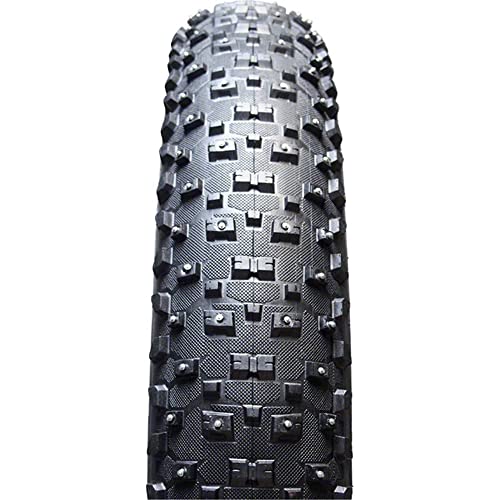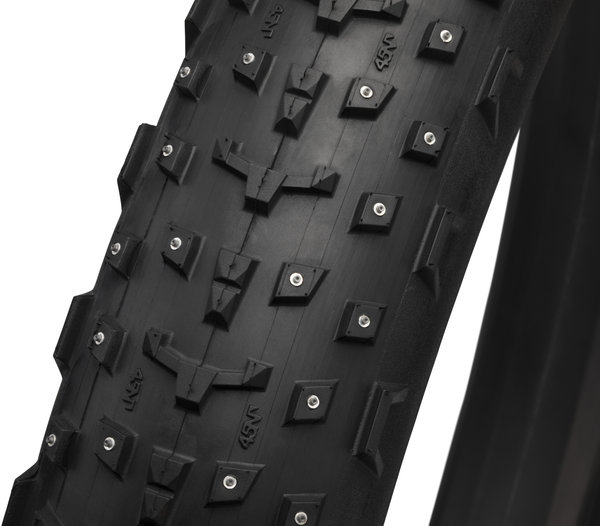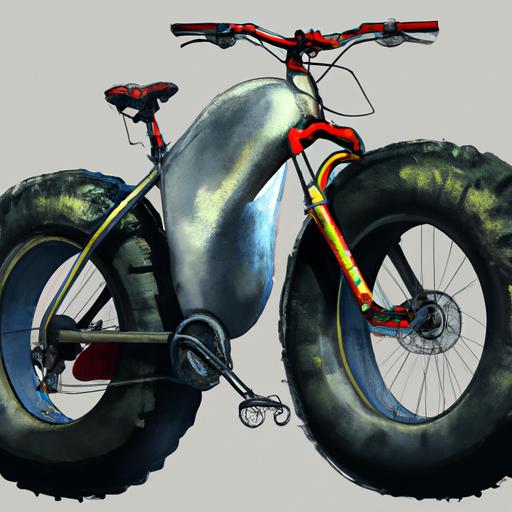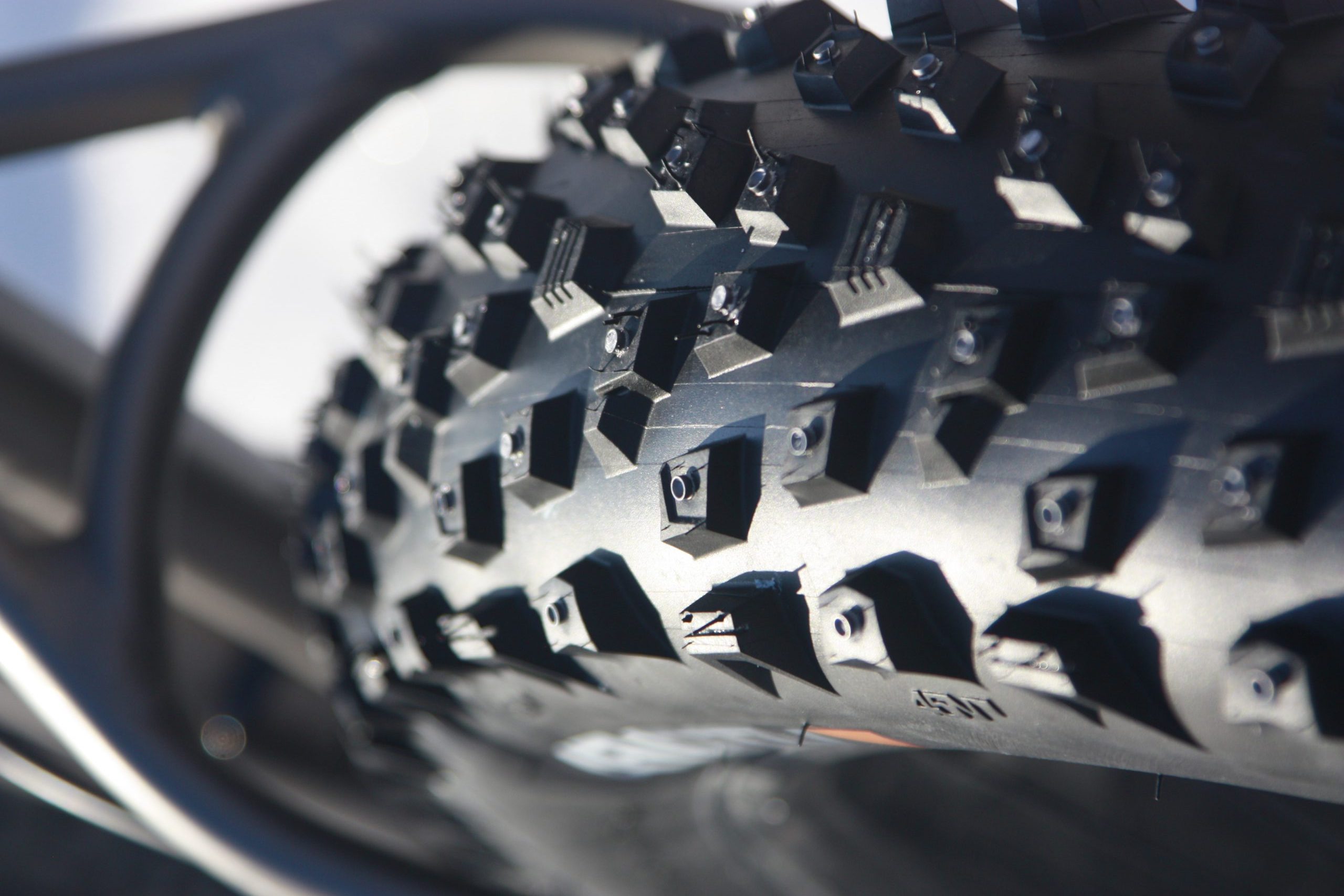Why Studded Tires are a Game-Changer for Fat Bike Enthusiasts
For fat bike enthusiasts, winter riding can be a thrilling experience, but it also comes with its own set of challenges. One of the most significant hurdles is navigating snowy and icy terrain, which can be treacherous even for the most experienced riders. This is where studded fat bike tires come into play, offering a game-changing solution for those who refuse to let the cold weather get in the way of their cycling adventures.
Studded fat bike tires are specifically designed to provide improved traction, control, and safety on snowy and icy surfaces. The studs, typically made of metal or hard rubber, are strategically placed on the tire to dig into the ice and snow, providing a secure grip that allows riders to corner, brake, and accelerate with confidence. This is particularly important for fat bike riders, who often venture into remote areas where the terrain can be unpredictable and the weather conditions harsh.
The benefits of using studded fat bike tires are numerous. For one, they significantly reduce the risk of accidents caused by slipping or sliding on icy surfaces. This is especially important for riders who are new to winter cycling or who are not familiar with the terrain. Additionally, studded tires provide improved control and stability, allowing riders to tackle challenging terrain with greater ease and precision.
Furthermore, studded fat bike tires can be a valuable asset for riders who participate in winter cycling events or competitions. By providing improved traction and control, these tires can give riders a competitive edge, allowing them to push themselves harder and faster than ever before.
Overall, studded fat bike tires are a must-have for any serious fat bike enthusiast. Whether you’re a seasoned pro or just starting out, these tires can help you take your winter cycling experience to the next level. With their improved traction, control, and safety, studded fat bike tires are the perfect solution for anyone looking to ride with confidence and precision in the snow and ice.
How to Choose the Right Studded Fat Bike Tires for Your Winter Adventures
With the numerous options available in the market, selecting the right studded fat bike tires can be a daunting task. However, by considering a few key factors, you can make an informed decision that meets your specific needs and preferences. Here are some tips to help you choose the best studded fat bike tires for your winter adventures.
Tire width is a critical factor to consider when choosing studded fat bike tires. A wider tire provides more surface area, which can improve traction and stability on snowy and icy terrain. However, wider tires can also be heavier and more prone to rolling resistance. Typically, studded fat bike tires range from 3.7 to 4.8 inches in width, so it’s essential to choose a width that balances traction and efficiency.
Stud pattern is another crucial factor to consider. The stud pattern refers to the arrangement of studs on the tire, which can affect traction, durability, and noise levels. Some studded fat bike tires feature a symmetrical stud pattern, while others have an asymmetrical pattern. Symmetrical stud patterns tend to provide better traction on ice, while asymmetrical patterns are better suited for snowy terrain.
Tire pressure is also an essential factor to consider when choosing studded fat bike tires. Running the correct tire pressure can significantly impact traction, efficiency, and durability. Typically, studded fat bike tires require lower pressure than non-studded tires, so it’s essential to check the manufacturer’s recommendations and adjust the pressure accordingly.
Additionally, consider the type of riding you’ll be doing most often. If you’ll be riding on mostly icy terrain, look for studded fat bike tires with a high number of studs and a more aggressive tread pattern. If you’ll be riding on mostly snowy terrain, look for tires with a more subtle tread pattern and fewer studs.
Finally, consider the brand and quality of the studded fat bike tires. Look for reputable brands that specialize in winter cycling tires, and check the tire’s construction, materials, and warranty. A high-quality studded fat bike tire may cost more upfront, but it can provide better performance, durability, and safety in the long run.
By considering these factors, you can choose the right studded fat bike tires for your winter adventures. Remember to always check the manufacturer’s recommendations and adjust the tire pressure accordingly. With the right studded fat bike tires, you can enjoy a safer, more enjoyable, and more efficient winter cycling experience.
Top Picks: Reviewing the Best Studded Fat Bike Tires on the Market
With so many studded fat bike tires available, it can be challenging to choose the right one for your winter cycling needs. To help you make an informed decision, we’ve reviewed some of the top-rated studded fat bike tires on the market. Here are our top picks, including their features, pros, and cons.
Surly Lou: The Surly Lou is a popular choice among fat bike enthusiasts, and for good reason. This tire features a unique stud pattern that provides excellent traction on ice and snow, while its 3.8-inch width offers a comfortable ride on rough terrain. The Surly Lou is also relatively lightweight, making it a great option for riders who want to maintain their bike’s agility.
45NRTH Dillinger: The 45NRTH Dillinger is another top-rated studded fat bike tire that’s designed for extreme winter conditions. This tire features a more aggressive stud pattern than the Surly Lou, making it ideal for riders who frequently encounter icy terrain. The Dillinger also has a slightly wider width than the Lou, at 4.0 inches, which provides even more stability and control.
Specialized Ground Control Fat: The Specialized Ground Control Fat is a high-end studded fat bike tire that’s designed for serious winter cyclists. This tire features a unique tread pattern that provides excellent traction on snow and ice, while its 4.2-inch width offers a comfortable ride on rough terrain. The Ground Control Fat is also relatively lightweight, making it a great option for riders who want to maintain their bike’s agility.
Maxxis Colossus: The Maxxis Colossus is a budget-friendly studded fat bike tire that’s designed for casual winter cyclists. This tire features a more subtle stud pattern than the other options on this list, making it ideal for riders who primarily encounter snowy terrain. The Colossus also has a slightly narrower width than the other options, at 3.5 inches, which makes it a great option for riders who want a more agile bike.
When choosing a studded fat bike tire, it’s essential to consider your specific needs and preferences. If you’re a serious winter cyclist who frequently encounters icy terrain, the 45NRTH Dillinger or Specialized Ground Control Fat may be the best option. However, if you’re a casual winter cyclist who primarily encounters snowy terrain, the Surly Lou or Maxxis Colossus may be a better choice.
Understanding the Technology Behind Studded Fat Bike Tires
Studded fat bike tires are a marvel of modern technology, designed to provide unparalleled traction and control on snowy and icy terrain. But have you ever wondered what makes these tires so effective? In this section, we’ll delve into the technology and design behind studded fat bike tires, including the materials used, stud placement, and tire construction.
The materials used in studded fat bike tires are a critical factor in their performance. The tire’s rubber compound is typically designed to be more flexible and grippy than regular bike tires, allowing it to conform to the terrain and provide better traction. The studs themselves are usually made of a hard, durable material such as tungsten carbide or steel, which provides excellent grip on ice and snow.
The placement of the studs is also crucial in determining the tire’s performance. Studded fat bike tires typically feature a symmetrical or asymmetrical stud pattern, which is designed to provide optimal traction and control on different types of terrain. The studs are usually placed in a way that allows them to dig into the ice and snow, providing a secure grip and preventing the tire from slipping or sliding.
Tire construction is another important factor in the performance of studded fat bike tires. The tire’s casing is typically designed to be more robust and durable than regular bike tires, with a thicker sidewall and a more aggressive tread pattern. This allows the tire to withstand the rigors of winter riding, including rough terrain and extreme weather conditions.
Some studded fat bike tires also feature advanced technologies such as tubeless compatibility, which allows riders to run lower tire pressures and improve traction and control. Others may feature specialized tread patterns or stud designs, which are designed to provide optimal performance on specific types of terrain.
Overall, the technology and design behind studded fat bike tires are a key factor in their performance and effectiveness. By understanding how these tires work, riders can better appreciate the benefits they provide and make more informed decisions when choosing the right tire for their winter cycling needs.
Installing and Maintaining Your Studded Fat Bike Tires
Installing and maintaining your studded fat bike tires is crucial to ensure optimal performance and longevity. In this section, we’ll provide step-by-step instructions on how to install and maintain your studded fat bike tires, including tips on tire pressure, stud maintenance, and storage.
Installing Studded Fat Bike Tires:
1. Before installing your studded fat bike tires, make sure to clean the rim and tire bed to ensure a proper seal.
2. Apply a thin layer of tire sealant to the rim and tire bed to prevent air leaks.
3. Install the tire on the rim, making sure to align the valve stem with the rim’s valve hole.
4. Inflate the tire to the recommended pressure, which can be found on the sidewall or in the manufacturer’s instructions.
Maintaining Studded Fat Bike Tires:
1. Check the tire pressure regularly, as under-inflation can lead to reduced traction and increased risk of punctures.
2. Inspect the studs regularly for wear and damage, and replace them as needed.
3. Clean the tire regularly to prevent dirt and debris from accumulating and causing damage.
4. Store the tire in a cool, dry place when not in use, away from direct sunlight and moisture.
Tips for Tire Pressure:
1. Use a tire pressure gauge to ensure accurate readings.
2. Check the tire pressure before each ride, as temperature changes can affect pressure.
3. Adjust the tire pressure according to the manufacturer’s recommendations and your personal preference.
Tips for Stud Maintenance:
1. Use a stud cleaning tool to remove dirt and debris from the studs.
2. Apply a small amount of lubricant to the studs to prevent corrosion and wear.
3. Replace the studs as needed, or according to the manufacturer’s recommendations.
By following these steps and tips, you can ensure optimal performance and longevity from your studded fat bike tires.
Tips for Riding with Studded Fat Bike Tires: Techniques and Best Practices
Riding with studded fat bike tires requires a combination of skill, knowledge, and practice. In this section, we’ll provide tips and techniques for riding safely and effectively with studded fat bike tires, including cornering, braking, and climbing.
Cornering with Studded Fat Bike Tires:
1. Approach corners slowly and deliberately, using the correct body position and weight distribution.
2. Look where you want to go, keeping your eyes focused on the exit of the corner.
3. Use gentle, smooth inputs on the handlebars to steer the bike through the corner.
Braking with Studded Fat Bike Tires:
1. Use both brakes evenly, applying gentle pressure to avoid locking up the wheels.
2. Look where you want to go, keeping your eyes focused on the path ahead.
3. Use the correct body position and weight distribution to maintain control and stability.
Climbing with Studded Fat Bike Tires:
1. Use a steady, consistent pace to maintain momentum and control.
2. Keep your weight centered over the bike, using the correct body position and weight distribution.
3. Use gentle, smooth inputs on the pedals to maintain traction and avoid wheel spin.
Additional Tips for Riding with Studded Fat Bike Tires:
1. Always wear proper safety gear, including a helmet, gloves, and warm clothing.
2. Ride within your abilities and experience level, avoiding terrain that is beyond your skill level.
3. Keep your bike in good working condition, regularly checking and maintaining the tires, brakes, and other components.
By following these tips and techniques, you can ride safely and effectively with studded fat bike tires, enjoying the many benefits and advantages they provide.
Common Mistakes to Avoid When Using Studded Fat Bike Tires
While studded fat bike tires can provide a significant advantage on snowy and icy terrain, there are several common mistakes to avoid when using them. In this section, we’ll discuss some of the most common mistakes and provide tips on how to avoid them.
Under-Inflating Tires:
One of the most common mistakes when using studded fat bike tires is under-inflating them. This can lead to reduced traction, increased risk of punctures, and decreased control. To avoid this mistake, always check the tire pressure before each ride and adjust it according to the manufacturer’s recommendations.
Riding Too Aggressively:
Riding too aggressively on studded fat bike tires can lead to loss of control, reduced traction, and increased risk of accidents. To avoid this mistake, always ride within your abilities and experience level, and adjust your speed and cornering style according to the terrain and conditions.
Neglecting Maintenance:
Neglecting maintenance on studded fat bike tires can lead to reduced performance, increased risk of punctures, and decreased safety. To avoid this mistake, always check the tires regularly for wear and damage, and perform routine maintenance tasks such as cleaning and lubricating the studs.
Not Adjusting to Changing Conditions:
Not adjusting to changing conditions, such as temperature, humidity, and terrain, can lead to reduced traction, increased risk of accidents, and decreased control. To avoid this mistake, always be aware of the changing conditions and adjust your riding style and tire pressure accordingly.
Not Using the Correct Stud Pattern:
Not using the correct stud pattern for the terrain and conditions can lead to reduced traction, increased risk of punctures, and decreased control. To avoid this mistake, always choose the correct stud pattern for the terrain and conditions, and adjust it according to the manufacturer’s recommendations.
By avoiding these common mistakes, you can ensure a safe and enjoyable winter cycling experience with studded fat bike tires.
Conclusion: Unlocking the Full Potential of Your Fat Bike with Studded Tires
Studded fat bike tires are a game-changer for fat bike enthusiasts, offering improved traction, control, and safety on snowy and icy terrain. By understanding the benefits, technology, and best practices for using studded fat bike tires, riders can unlock the full potential of their fat bike and enjoy a more enjoyable and safe winter cycling experience.
Whether you’re a seasoned fat bike enthusiast or just starting out, studded fat bike tires are a must-have for any winter cycling adventure. With their improved traction and control, studded fat bike tires can help you ride with confidence and precision, even in the most challenging winter conditions.
In this article, we’ve covered the benefits of using studded fat bike tires, including improved traction, control, and safety. We’ve also discussed the technology and design behind studded fat bike tires, including the materials used, stud placement, and tire construction.
In addition, we’ve provided tips and guidelines for selecting the best studded fat bike tires, including factors to consider such as tire width, stud pattern, and tire pressure. We’ve also reviewed and compared popular studded fat bike tire models, highlighting their features, pros, and cons.
Finally, we’ve offered step-by-step instructions on how to install and maintain studded fat bike tires, including tips on tire pressure, stud maintenance, and storage. We’ve also provided advice on how to ride safely and effectively with studded fat bike tires, including techniques for cornering, braking, and climbing.
By following the tips and guidelines outlined in this article, you can unlock the full potential of your fat bike and enjoy a more enjoyable and safe winter cycling experience with studded fat bike tires.







